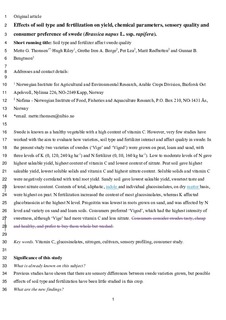Effects of soil type and fertilization on yield, chemical parameters, sensory quality and consumer preference of swede (Brassica napus L. ssp. rapifera)
Thomsen, Mette; Riley, H.; Borge, Grethe Iren Andersen; Lea, Per; Rødbotten, Marit; Bengtsson, Gunnar
Journal article, Peer reviewed
Submitted version
Permanent lenke
http://hdl.handle.net/11250/2481281Utgivelsesdato
2017Metadata
Vis full innførselSamlinger
- Artikler / Articles [1425]
- Publikasjoner fra CRIStin [2488]
Originalversjon
European Journal of Horticultural Science. 2017, 82 (6), 294-305. 10.17660/eJHS.2017/82.6.4Sammendrag
Swede is known as a healthy vegetable with a high content of vitamin C. However, very few studies have worked with the aim to evaluate how varieties, soil type and fertilizer interact and affect quality in swede. In the present study two varieties of swedes (‘Vige’ and ‘Vigod’) were grown on peat, loam and sand, with three levels of K (0, 120, 240 kg ha-1) and N fertilizer (0, 80, 160 kg ha-1). Low to moderate levels of N gave highest saleable yield, highest content of vitamin C and lowest content of nitrate. Peat soil gave highest saleable yield, lowest soluble solids and vitamin C and highest nitrate content. Soluble solids and vitamin C were negatively correlated with total root yield. Sandy soil gave lowest saleable yield, sweetest taste and lowest nitrate content. Contents of total, aliphatic, indole and individual glucosinolates, on dry matter basis, were highest on peat. N fertilization increased the content of most glucosinolates, whereas K affected glucobrassicin at the highest N level. Progoitrin was lowest in roots grown on sand, and was affected by N level and variety on sand and loam soils. Consumers preferred ‘Vigod’, which had the highest intensity of sweetness, although ‘Vige’ had more vitamin C and less nitrate.
